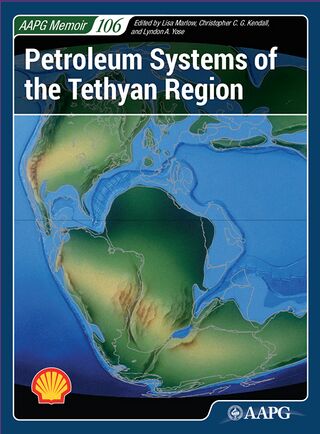Jordan petroleum geology
| Petroleum systems of the Tethyan region | |

| |
| Series | AAPG Memoir |
|---|---|
| Chapter | Petroleum Geology of Jordan |
| Author | Stebastian Lüning and Jochen Kuss |
| Link | Web page |
| Store | AAPG Store |
Only two hydrocarbon fields have been discovered in Jordan so far, despite the drilling of more than 120 petroleum wells. The Silurian-sourced and Ordovician-reservoired Risha gas field in Northeast Jordan originally had a recoverable gas reserve of around 350 billion cubic feet (bcf). Since production started in 1989, almost half has already been produced. According to Jordan’s National Petroleum Company (NPC), original gas reserves of the Risha field are up to 2–3 trillion cubic feet. The same play generated oil in the Wadi Sirhan area, where small amounts of light oil were tested in Well Wadi Sirhan-4 (WS-4). The second field in Jordan is the Hamzeh oil field in central North Jordan. However, with only modest original, recoverable reserves of 1 million barrels (MMBO), of which 0.86 MMBO has already been produced at an average rate of 40 barrels of oil per day. Current exploration in the country concentrates on Maastrichtian oil shale exploration in central Jordan, where the world’s fourth largest oil shale reserves are located. Organic richness in the Muwaqqar Chalk Marl Formation partly exceeds 20%. Besides traditional open pit mining, modern in situ oil generating techniques could be applied in Jordanian oil shale exploration. The same oil shale unit also exists underneath the Dead Sea pull-apart basin, where it is deeply buried in the oil and gas generative windows. Hydrocarbon indications occur across the Dead Sea Basin and include numerous oil and gas seeps, tar sands, heavy oil, and floating asphalt blocks in Dead Sea waters and on the shoreline. Nevertheless, exploration efforts in the Dead Sea have been disappointing so far and resulted in the discovery of just a few small commercial gas accumulations which lie on the Israeli side of the basin, namely the Zohar, Kidod, and Haqanaim gas fields. Other frontier plays in Jordan include the Cambrian in the Jafr Rift and the Triassic-Jurassic in northern Jordan.